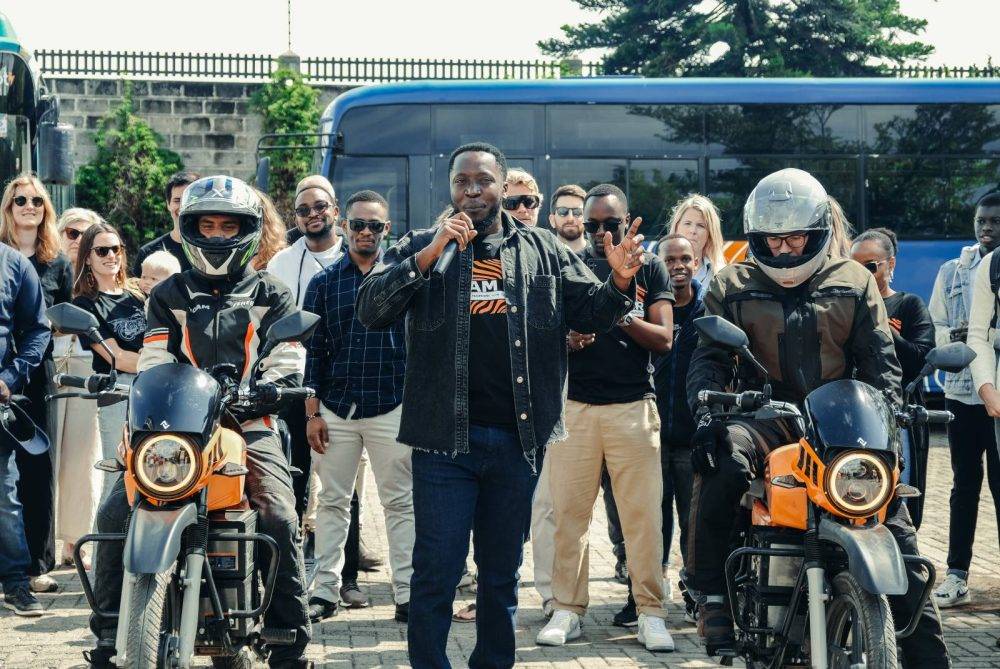An electric motorcycle, designed and built in Africa and powered by the sun, began its 6000km journey from Nairobi in Kenya to Stellenbosch in the Western Cape, on Sunday. (Supplied)
An electric motorcycle, designed and built in Africa and powered by the sun, began its 6000km journey from Nairobi in Kenya to Stellenbosch in the Western Cape, on Sunday.
Researchers from the faculty of engineering at Stellenbosch University have joined forces with Roam, a company in Nairobi, to test the Roam Air, an electric motorcycle used in urban settings.
“It’s exciting for me that what we’re doing is that we are supporting African collaboration and ingenuity,” said Thinus Booysen, founder of the university’s Electric Mobility Lab, which will be launched on 18 October.
“It’s a weird thing to do I think — to drive from Nairobi to Cape Town — but what we’re trying to do is to send a message that electric mobility is something that’s feasible and it’s feasible to be done with green energy.”
His concern is that Africa is lagging behind the rest of the world and increasingly importing vehicles from China.

“We’re importing vehicles that are not made for our terrain; vehicles that don’t necessarily meet our expectations and if we keep on importing vehicles, we’re going to lose local jobs. So, this is us trying to say ‘Hey, hang on, there is an alternative way to do this and to do it with green energy,’ so that we don’t kill our grids and so that we’re not dependent on dirty energy as it were.”
The electric motorcycle, accompanied by two support vehicles, is expected to arrive in Stellenbosch on 18 October, in time for the university’s Electric Mobility Day celebration. The expedition is partly to observe Transport Month in South Africa.
Roam donated two of its electric motorcycles to the lab for research and testing. “We cannot think of a better way to kickstart our research collaboration than testing the motorcycle overland,” Booysen said. “To do this within the African fraternity of ingenuity is an enormous privilege.”
Together, the university and Roam intend to develop and apply research on electric vehicles and the supporting ecosystem, including electric vehicle powertrains, local manufacturing and digital pilots for planning for electric urban mobility.
“This journey shows Kenya’s ability to design and locally manufacture world-class electric vehicles for African conditions,” said Masa Kituyi, electric motorcycles product owner at Roam, in a statement. “It’s a testament to local innovation, leading the way in sustainable mobility solutions.”
Kituyi and PhD candidate and co-researcher on the project, Stephan Lacock, are riding the motorcycle. “The emphasis is not on whether such a trip can be done, as there have been other similar journeys in the world, but rather to showcase African ingenuity and collaboration between Stellenbosch University and Roam to overcome African conditions with green solar energy,” Lacock said.
 (Graphic: John McCann/M&G)
(Graphic: John McCann/M&G)
Of the pair’s journey from Nairobi, Booysen said: “They are loving it and it’s extremely exciting and nerve-racking at the same time. But the route is definitely safe. They’ve actually told me they never felt this safe, ever since they left the South African border. They’re sleeping next to the road. And it’s so beautiful … The most nerve-racking part is crossing the borders with expensive equipment.”
Stellenbosch University’s research team is also interested in seeing the performance of the drivetrain and swappable batteries, as well as the efficacy of the solar recharging solution.
Booysen said electric motorbikes are taking off in Africa. “South Africa is actually way behind. There are tens of thousands of electric motorbikes in most of the big African cities. We’re talking Benin, Togo, we’re talking Nigeria, Kampala and Kigali.”
He recalled driving around Nairobi on Sunday where the streets were filled with electric vehicles. “These things have been doing thousands of kilometres. It’s definitely taking over because people are realising the benefits, obviously the cost benefits to the drivers.
“But the part that nobody talks about is the pollution benefit. I’m not talking about the climate change benefit; I’m talking about particulate matter and the health consequences of inhaling that particulate matter in our African cities.”
These cities are extremely polluted, leading to a heavy annual death toll, he said. “From an African perspective, our greenhouse gas emissions are not nearly as high as the rest of the world … but in terms of pollution, we’re facing a big challenge … That, for me, is one of the key benefits of going electric.”
South Africa is stuck in the slow lane towards electric mobility, Booysen said. “I think we’ve kind of dropped the ball because we were talking about electricity and load-shedding and those types of challenges. We kind of lost a policy plot on moving to electric mobility and getting manufacturing ready.”
More than 450 000 jobs in South Africa rely on the vehicle production sector. “That should have set a red flag as soon as countries [we export to] said, ‘we don’t want petrol and diesel vehicles anymore’.”
Booysen said the country is lagging behind because of poor policy and of being led by people “without vision and without political will”.
“You can see the political will is also not there in [other] African countries but they’re not as regulation-bound. People are taking up the opportunities because it’s loosely regulated,” he said.
The trip from Nairobi to Stellenbosch is supported by Scatec, Balancell, Voetspore, Tracks for Africa, Bush Lapa, South African National Energy Development Institute through the LEAP-RE project and Charlie’s Travel.
Source link : https://mg.co.za/the-green-guardian/2024-09-30-from-kenya-to-south-africa-a-solar-powered-electric-motorcycle-adventure/
Author :
Publish date : 2024-09-30 15:23:10
Copyright for syndicated content belongs to the linked Source.





